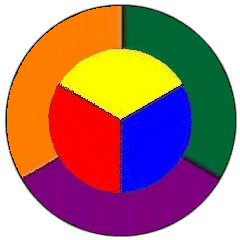
|
The colour-wheel
All colours can be made from the three "primary colours": Red, yellow & blue (seen here in the centre of the colourwheel) + black and/or white.
2 primary colours combined, make a "secondary colour": Orange, green or purple
i.e. Red + yellow = orange. Yellow + blue = green. Blue + red = purple.
2 secondary colours combined, make a "tertiary colour".
|